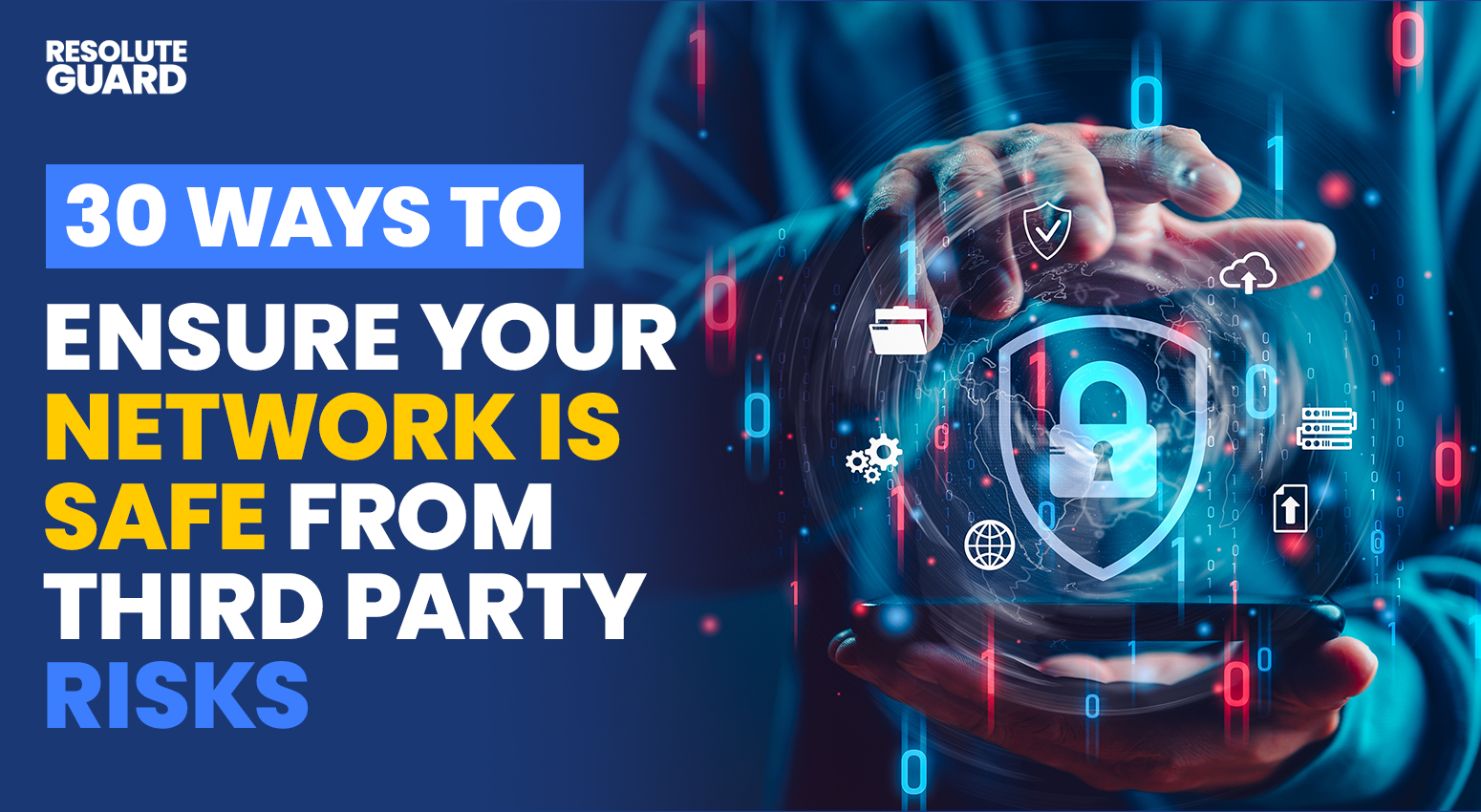30 Ways to Ensure Your Network is Safe From Third Party Risks
Ensuring the safety of your network from third-party risks is critical in today’s interconnected world, where companies often rely on external vendors, suppliers, and partners for various services. Here are 30 ways to secure your network against third-party risks:
- Conduct Thorough Due Diligence
- Vet Third Parties: Before engaging with third parties, thoroughly vet their security practices, reputation, and history of compliance. Ensure they meet your organization’s security standards.
- Review Security Certifications: Look for certifications such as ISO 27001, SOC 2, or other relevant security standards that indicate robust security practices.
- Implement Third-Party Risk Assessments
- Regular Assessments: Conduct regular risk assessments to evaluate the security posture of third parties. Identify potential vulnerabilities that could impact your network.
- Risk-Based Approach: Prioritize assessments based on the level of access or data sensitivity each third party has.
- Use Strong Contracts and SLAs
- Security Clauses: Include security requirements, data protection measures, and incident response obligations in contracts and Service Level Agreements (SLAs).
- Right to Audit: Ensure contracts grant you the right to audit third-party security practices regularly.
- Limit Third-Party Access
- Principle of Least Privilege: Grant third parties only the access they need to perform their tasks, nothing more.
- Segmented Network Access: Use network segmentation to limit third-party access to only the necessary parts of your network.
- Implement Strong Authentication and Authorization
- Multi-Factor Authentication (MFA): Require MFA for third-party access to your network and sensitive systems.
- Role-Based Access Control (RBAC): Implement RBAC to ensure that third-party users only have access to the resources necessary for their roles.
- Monitor and Log Third-Party Activity
- Continuous Monitoring: Set up continuous monitoring of third-party activities on your network to detect unusual behavior or unauthorized access.
- Audit Logs: Maintain detailed logs of all third-party access and actions on your network. Regularly review these logs for any anomalies.
- Conduct Regular Security Training
- Third-Party Security Awareness: Provide security awareness training to third-party employees who have access to your network, focusing on your security policies and procedures.
- Internal Training: Ensure your employees are trained on how to securely manage third-party relationships and recognize potential risks.
- Implement a Vendor Risk Management Program
- Centralized Management: Develop a centralized vendor risk management program that oversees the onboarding, monitoring, and offboarding of third parties.
- Regular Review: Periodically review and update the program to address emerging threats and changes in the threat landscape.
- Use Secure Communication Channels
- Encrypted Communication: Require the use of encrypted communication channels (e.g., VPNs, TLS) for all data exchanges with third parties.
- Secure File Transfers: Implement secure methods for transferring sensitive data, such as SFTP or encrypted email.
- Establish Incident Response Procedures
- Joint Incident Response Plans: Develop and agree on joint incident response plans with third parties, including clear communication protocols.
- Notification Requirements: Ensure third parties are required to notify you immediately if they experience a security incident that could impact your network.
- Perform Penetration Testing
- Third-Party Access Testing: Regularly conduct penetration tests that include scenarios involving third-party access to your network to identify vulnerabilities.
- Collaborative Testing: Consider conducting joint penetration tests with critical third parties to evaluate the security of interconnected systems.
- Use Data Loss Prevention (DLP) Solutions
- DLP Implementation: Deploy DLP tools to monitor and control data transferred to and from third parties, ensuring sensitive data is not leaked or mishandled.
- Policy Enforcement: Create and enforce DLP policies specifically for third-party interactions.
- Implement Network Segmentation
- Isolated Environments: Use network segmentation to isolate third-party access from your core network and sensitive systems.
- Micro-Segmentation: Implement micro-segmentation within your network to provide even finer-grained access controls for third parties.
- Conduct Regular Security Audits
- Third-Party Audits: Regularly audit the security practices of third parties, focusing on their adherence to your security requirements.
- Compliance Checks: Ensure third parties remain compliant with relevant industry regulations and standards.
- Establish Data Handling and Retention Policies
- Data Minimization: Require third parties to adhere to data minimization principles, ensuring they only collect and retain data necessary for their tasks.
- Secure Disposal: Ensure third parties have secure data disposal procedures for any sensitive information related to your organization.
- Regularly Update Software and Patches
- Third-Party Software Patching: Ensure that all third-party software and tools used on your network are regularly updated and patched to protect against vulnerabilities.
- Automated Patch Management: Implement automated patch management processes to keep systems secure.
- Implement Security Information and Event Management (SIEM)
- Centralized Monitoring: Use SIEM tools to centralize the monitoring and analysis of security events related to third-party access.
- Threat Detection: Leverage SIEM for real-time threat detection and response, focusing on potential risks from third-party interactions.
- Review and Update Access Controls Regularly
- Periodic Review: Regularly review and update access controls for third parties, ensuring they still align with current needs and security policies.
- Access Revocation: Promptly revoke access for third parties that no longer need it or that have ended their relationship with your organization.
- Implement a Zero-Trust Architecture
- Zero-Trust Principles: Adopt a zero-trust security model where no entity, internal or external, is trusted by default. All access must be verified, including for third parties.
- Continuous Verification: Continuously verify the identity and security posture of third-party users and devices before granting access to your network.
- Use Cloud Access Security Brokers (CASB)
- Cloud Security Enforcement: Deploy a CASB to monitor and enforce security policies for third-party access to cloud resources.
- Visibility and Control: Use CASB to gain visibility into third-party cloud interactions and ensure compliance with your security requirements.
- Encrypt Sensitive Data
- Data Encryption: Ensure that all sensitive data exchanged with third parties is encrypted both in transit and at rest.
- Key Management: Implement robust key management practices to control access to encryption keys, ensuring only authorized parties can decrypt data.
- Establish Clear Offboarding Procedures
- Revoke Access: Implement procedures to promptly revoke access for third parties when their services are no longer needed.
- Data Retrieval and Deletion: Ensure that all data shared with the third party is either returned or securely deleted upon termination of the relationship.
- Implement Endpoint Detection and Response (EDR)
- Endpoint Security: Deploy EDR solutions to monitor and secure endpoints used by third parties, ensuring they are protected against malware and other threats.
- Behavioral Analysis: Use EDR tools to detect and respond to suspicious behavior on third-party devices connected to your network.
- Use Secure Software Development Practices
- Secure Coding: Ensure that third-party developers adhere to secure coding practices when developing software that will be used on your network.
- Code Reviews: Conduct code reviews and security testing on third-party software to identify potential vulnerabilities before deployment.
- Establish Continuous Security Monitoring
- Real-Time Monitoring: Continuously monitor third-party access and activities on your network to detect and respond to threats in real time.
- Automated Alerts: Set up automated alerts for any suspicious or unauthorized third-party activity, enabling quick response.
- Regularly Update and Test Disaster Recovery Plans
- Third-Party Involvement: Include third parties in your disaster recovery planning and testing, ensuring they can support your organization in case of an incident.
- Plan Review: Regularly review and update your disaster recovery plans to account for changes in third-party relationships and technology.
- Implement Multi-Layered Security Controls
- Defense in Depth: Apply multiple layers of security controls, such as firewalls, intrusion detection systems, and access controls, to protect against third-party risks.
- Redundancy: Ensure redundancy in your security measures to maintain protection even if one layer fails.
- Enforce Security Policies Consistently
- Policy Enforcement: Ensure that all third parties are aware of and adhere to your organization’s security policies. Consistent enforcement is key to mitigating risks.
- Regular Updates: Regularly update security policies to address new threats and communicate these updates to third parties.
- Develop a Third-Party Risk Awareness Program
- Internal Awareness: Educate your employees on the risks associated with third-party interactions and the importance of following security protocols.
- Vendor Education: Share security best practices with your third-party vendors to ensure they understand and comply with your security expectations.
- Engage in Continuous Improvement
- Regular Evaluations: Continuously evaluate and improve your third-party risk management practices to adapt to the evolving threat landscape.
- Feedback Loops: Establish feedback loops with third parties to regularly assess and enhance security measures based on real-world experiences and incidents.
Conclusion
Mitigating third-party risks requires a comprehensive and proactive approach that combines strong security practices, continuous monitoring, and collaboration with third-party vendors. By implementing these 30 strategies, you can significantly reduce the likelihood of security incidents originating from third-party interactions, ensuring that your network remains secure and resilient in the face of evolving threats. Regular reviews, updates, and a commitment to security excellence are essential components of an effective third-party risk management strategy.

